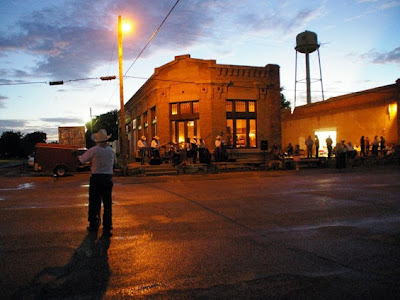The Side Kicks performing in Goree, Texas; photograph by Hanaba Munn Welch
Legal Ruralism is a site that we've been wanting to highlight for a while: it's a blog with a staff of two dozen writers that discusses issues of law, governance, and policy--and many other elements of contemporary rural life. Recent posts have considered President Obama's signing of the Tribal Law and Order Act, the bias against rural whites in college admissions, and a fascinating report on how the town of Beatrice, Nebraska passed their Homestead Act of 2010 in order to reap the tax benefits from vacant properties. Legal Ruralism is an invaluable resource, and it's one of the sites that fall under our "daily reading" category.
They recently offered a link to Wade Goodwyn's NPR piece on the Bobby Boatright Memorial Music Camp in Goree, Texas. Established in memory of a local fiddle player who died of leukemia, the Camp serves as one of the dwindling opportunities for this small town (population 300) to come together as a community. It's a chance for local youth to learn the music of their parents and grandparents; in a town in danger of disappearing from the map, folks are seeing this camp--and this musical heritage--as a way to preserve families, culture, and even a sense of economic sustainability. Here's an excerpt from Mr. Goodwyn's report:
The camp is housed in what used to be the junior high in Goree — that is until last September, when the school district gave the building and campus back to the town and said, "Good luck." That was a big blow because the junior high was pretty much the only reason anyone still came to Goree.
Tammy Trainham looks out over the school courtyard and smiles. She is the mayor's wife and this is her doing — she talked them into bringing the fiddle camp here. These five days are all that's left between Goree and oblivion.
"We're trying to rebirth a town," Trainham says. "It was dead — graveyard dead."
If you're new to western swing, the NPR link will provide a few other articles that will help to tell the story of this music and its artists. Western swing has a special place here at The Art Of The Rural: our first post discussed Texas Dancehall Preservation, and Bob Wills and His Texas Playboys are always in constant rotation. Leading into the weekend, we'd suggest checking out their Tiffany Transcriptions records. If you are familiar with their studio recordings, the Tiffany recordings will be a revelation--with a little more room to expand the songs, it's easy to see Mr. Wills as country music's Duke Ellington (they do indeed cover some of Duke's compositions) and the Texas Playboys as a group that undoubtedly cleared a path for later rock musicians--some of the guitar and pedal steel solos on these records are just scorching. Here's a television performance of "Ida Red;" it lacks the verve and grit of the version of the Tiffany Transcriptions recording, but still swings:






















